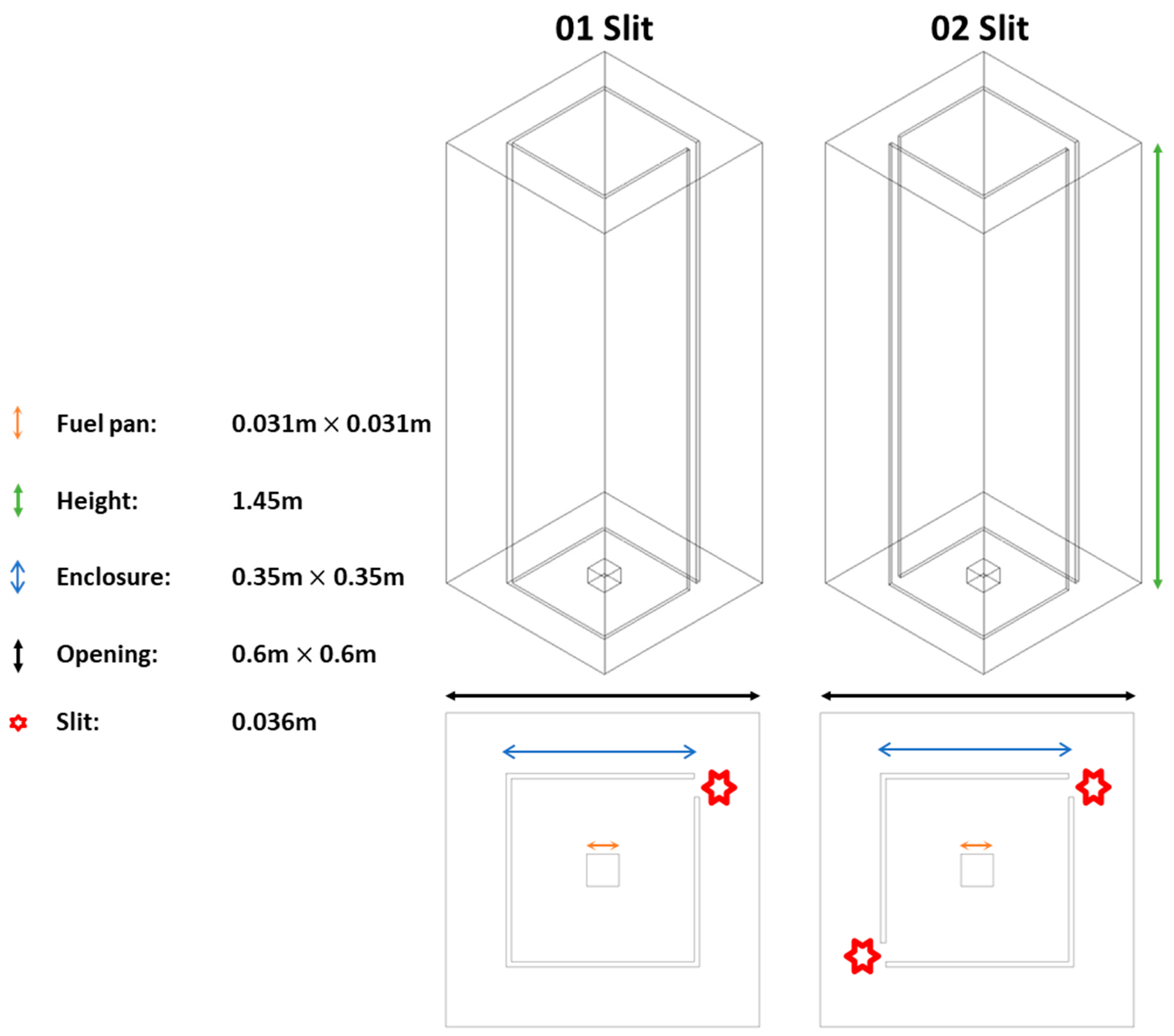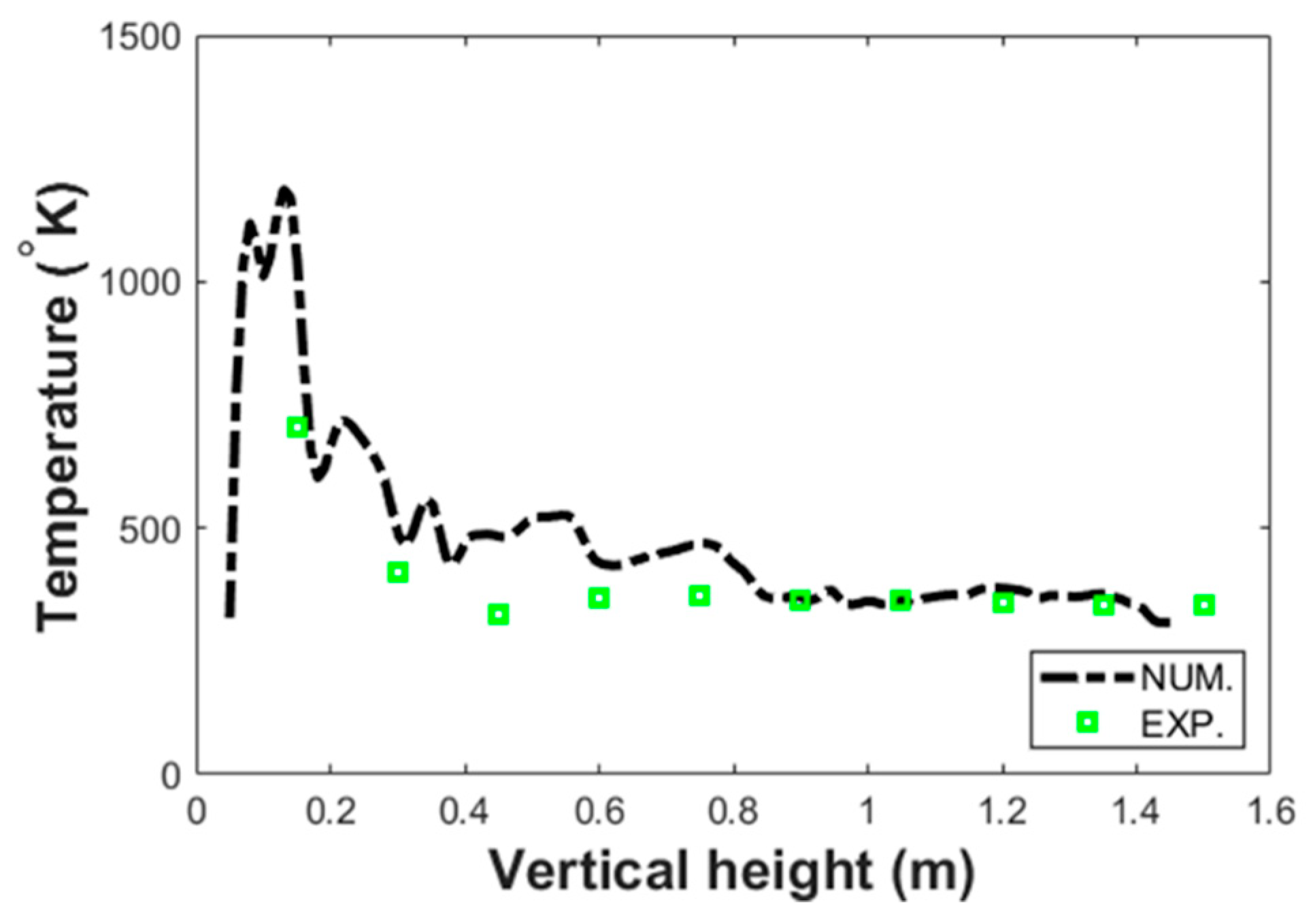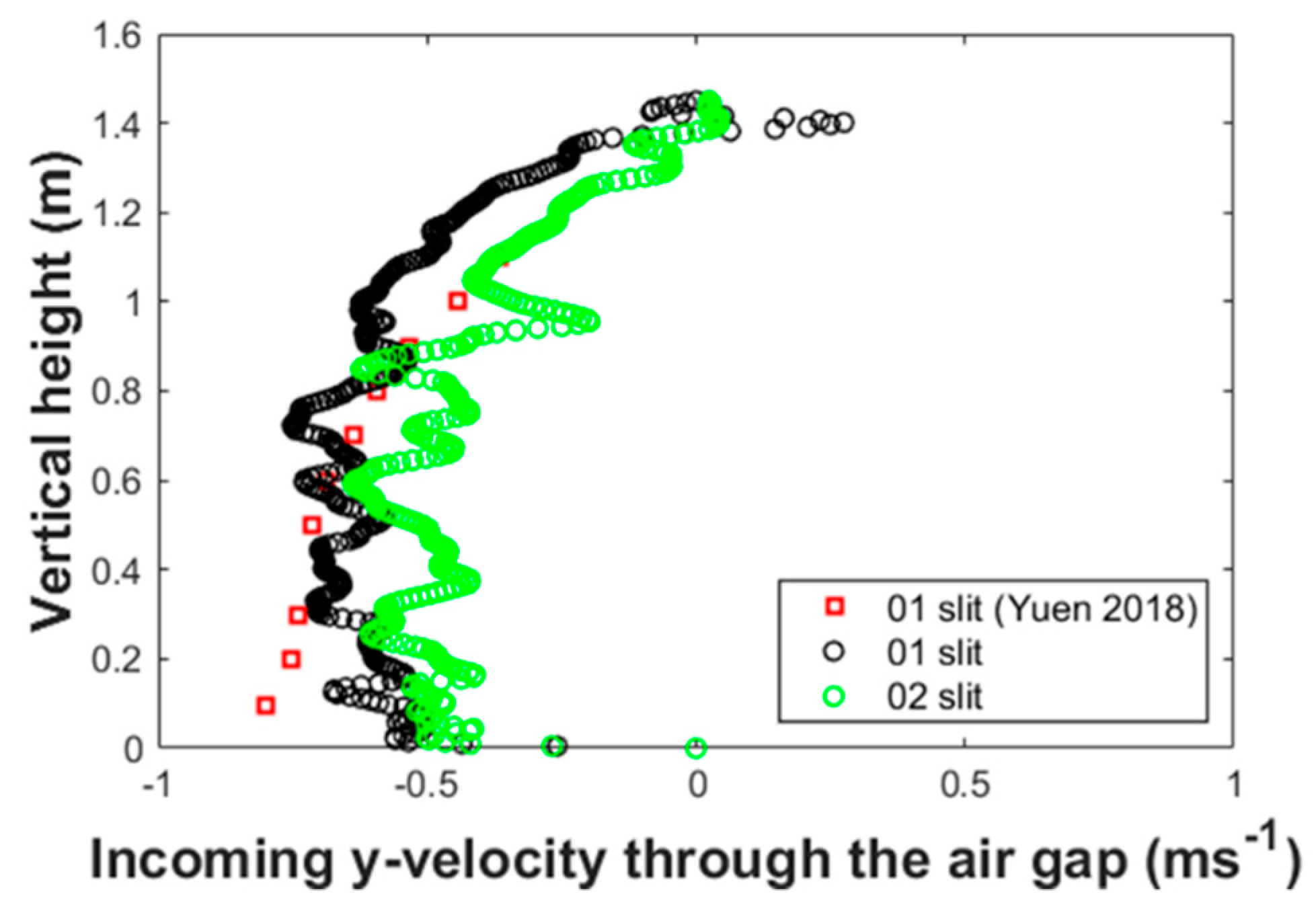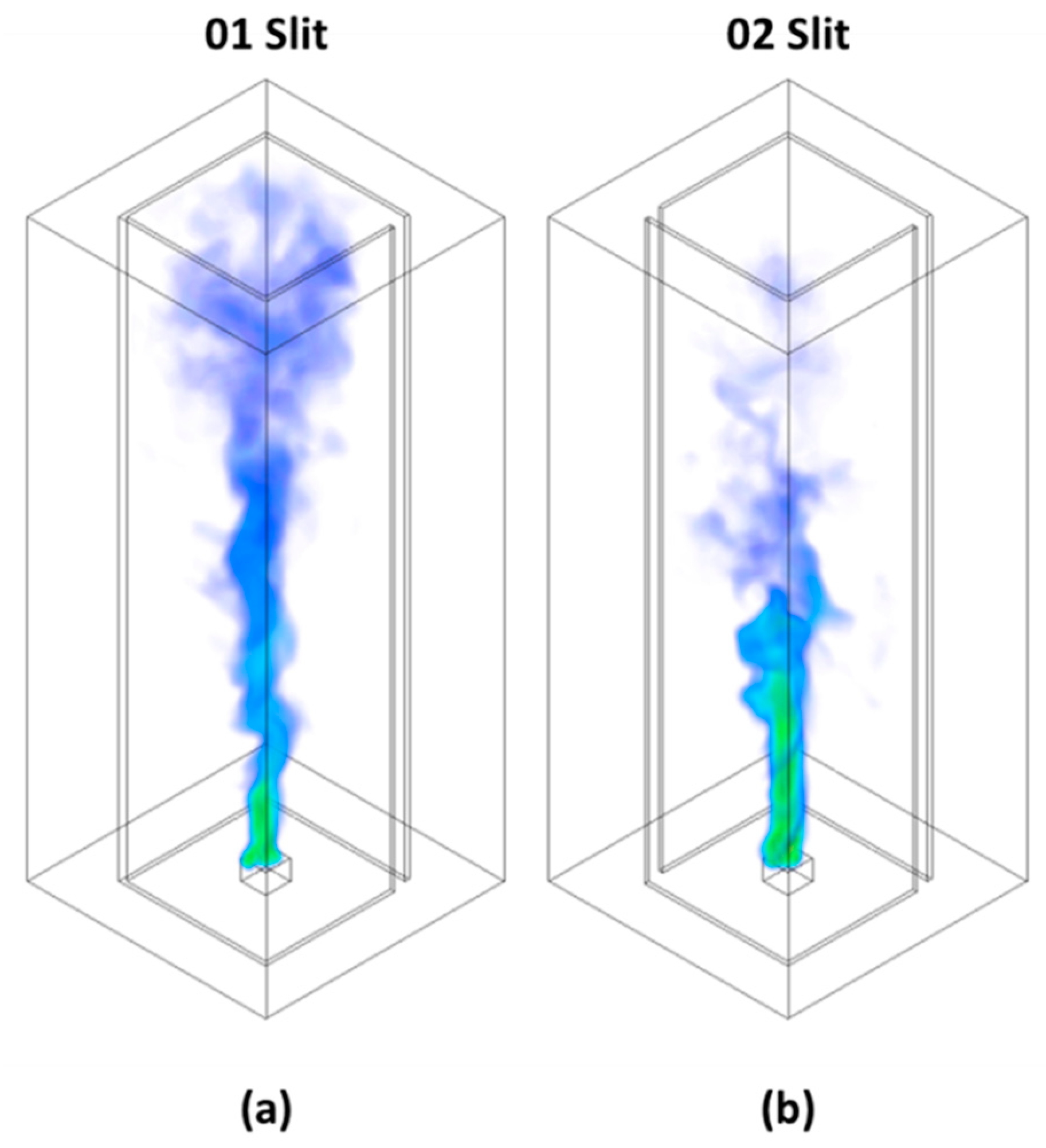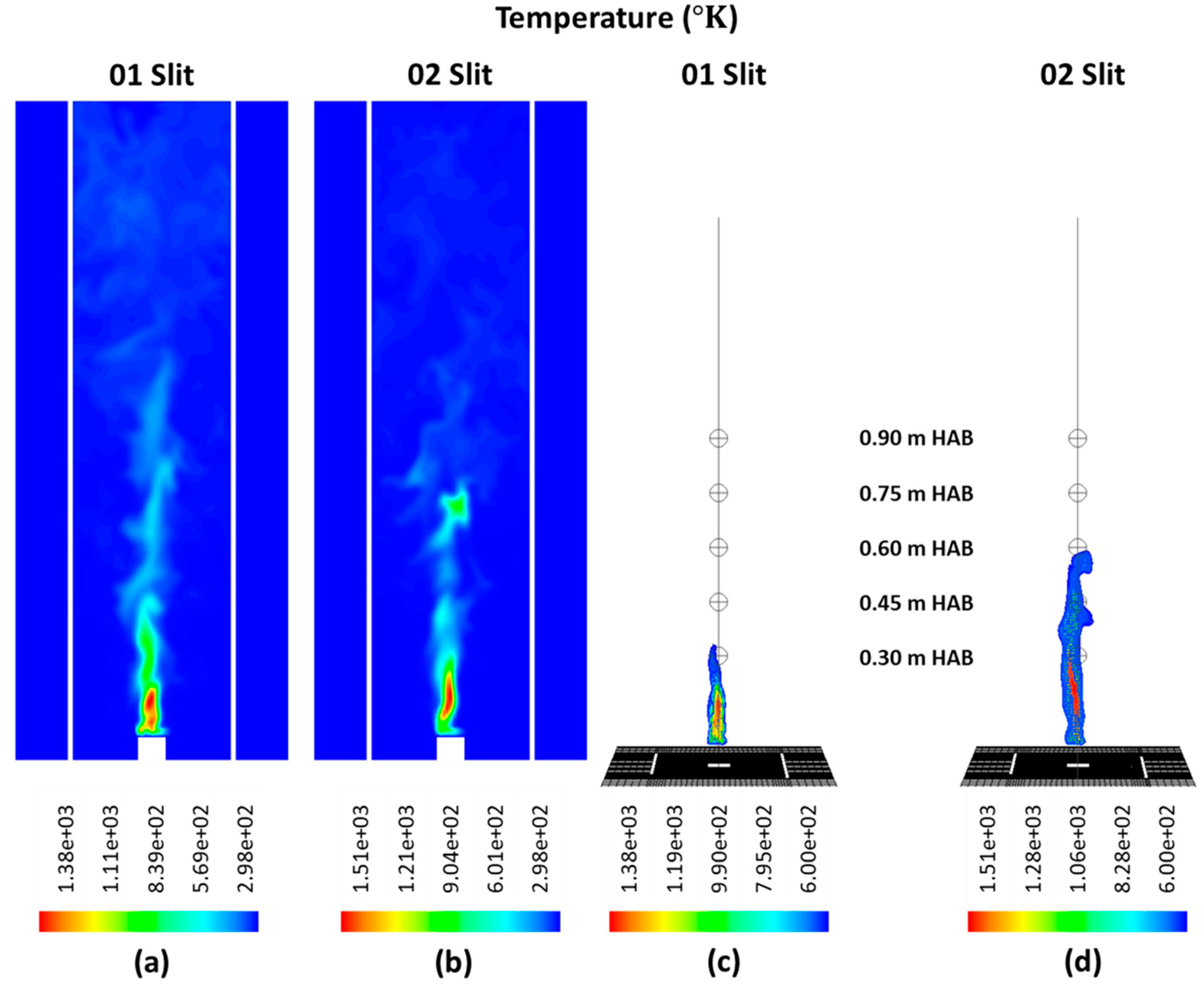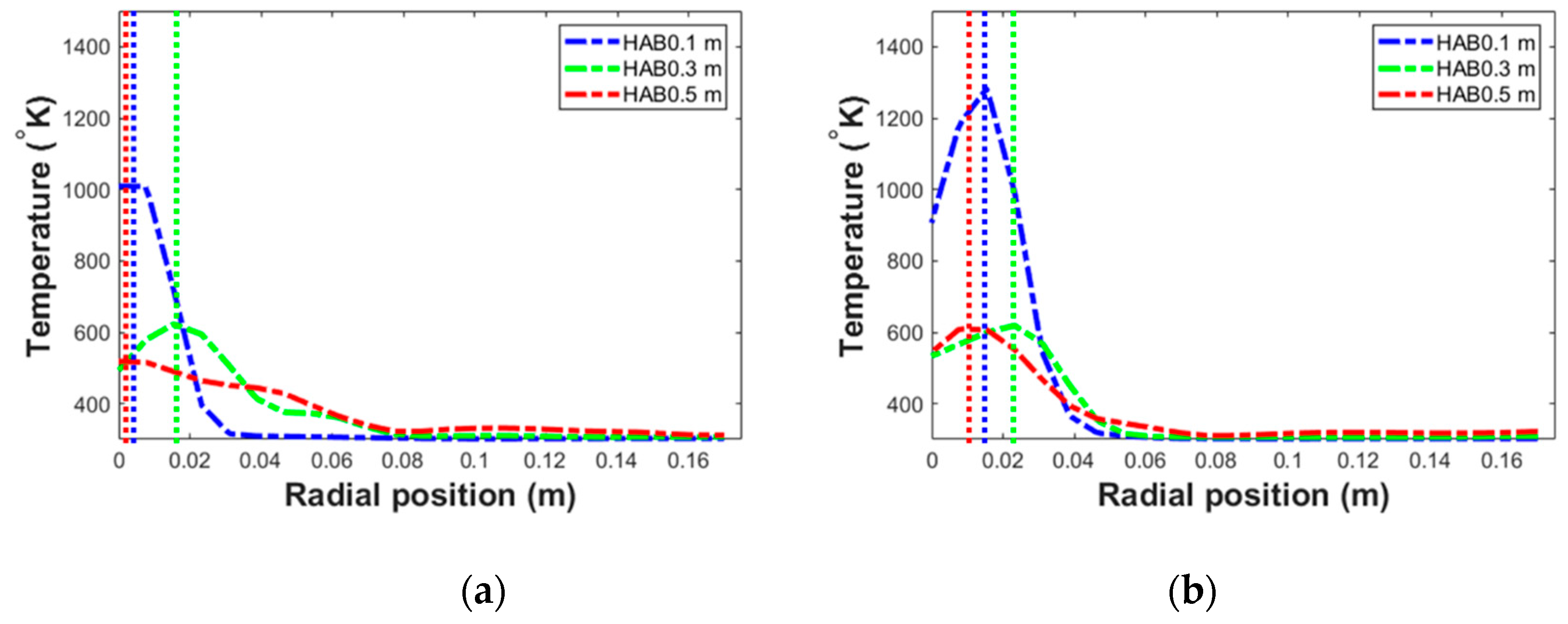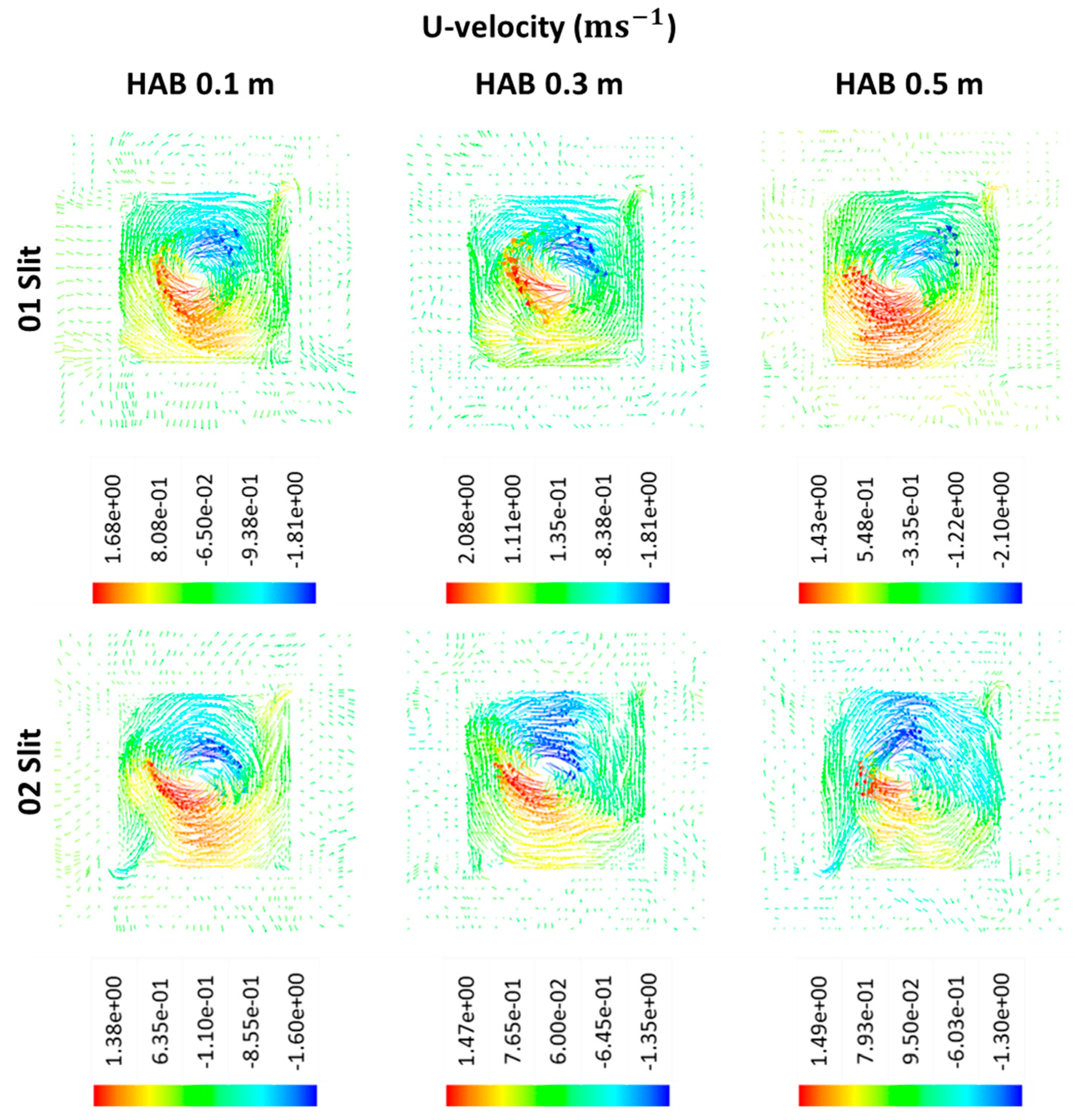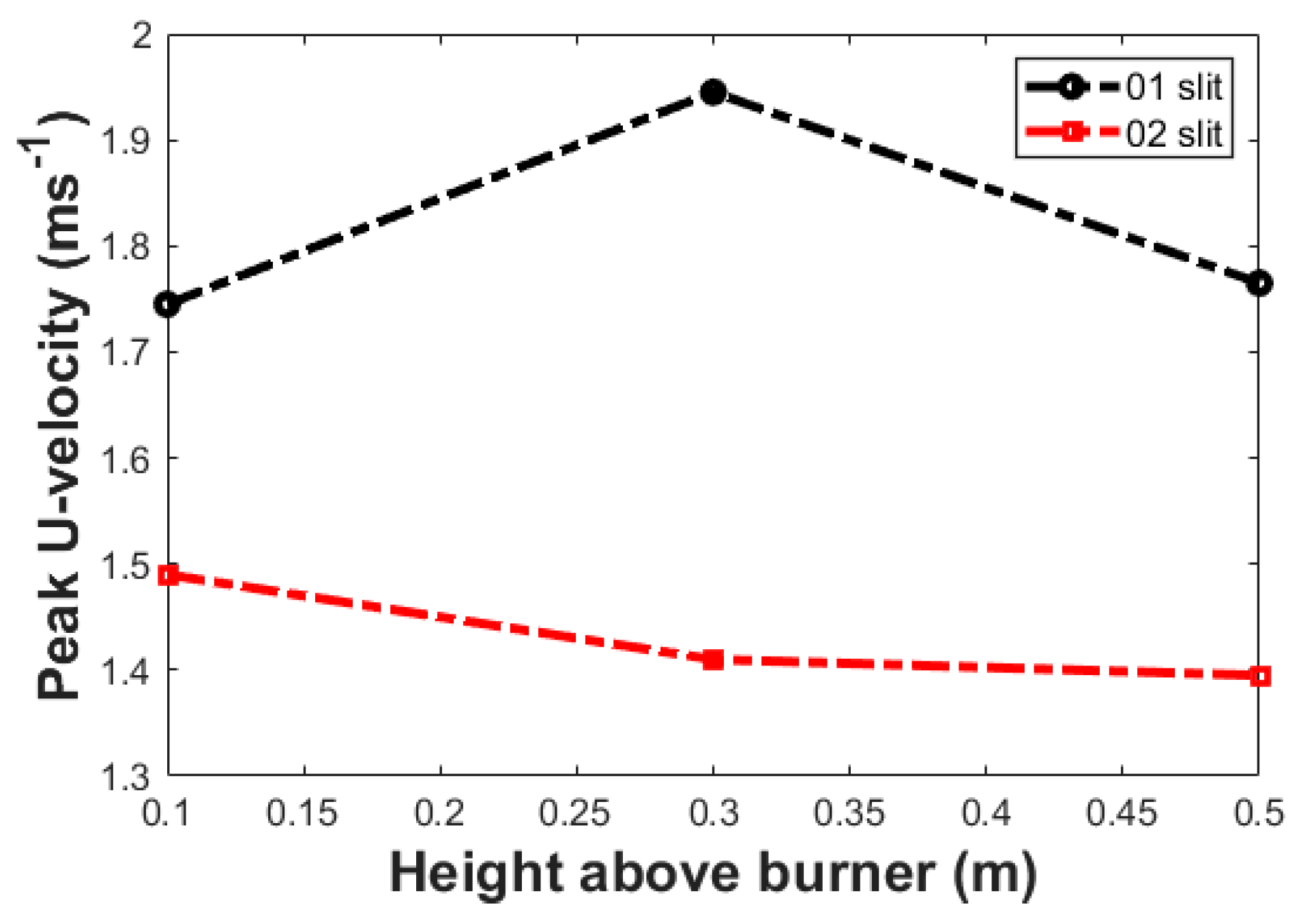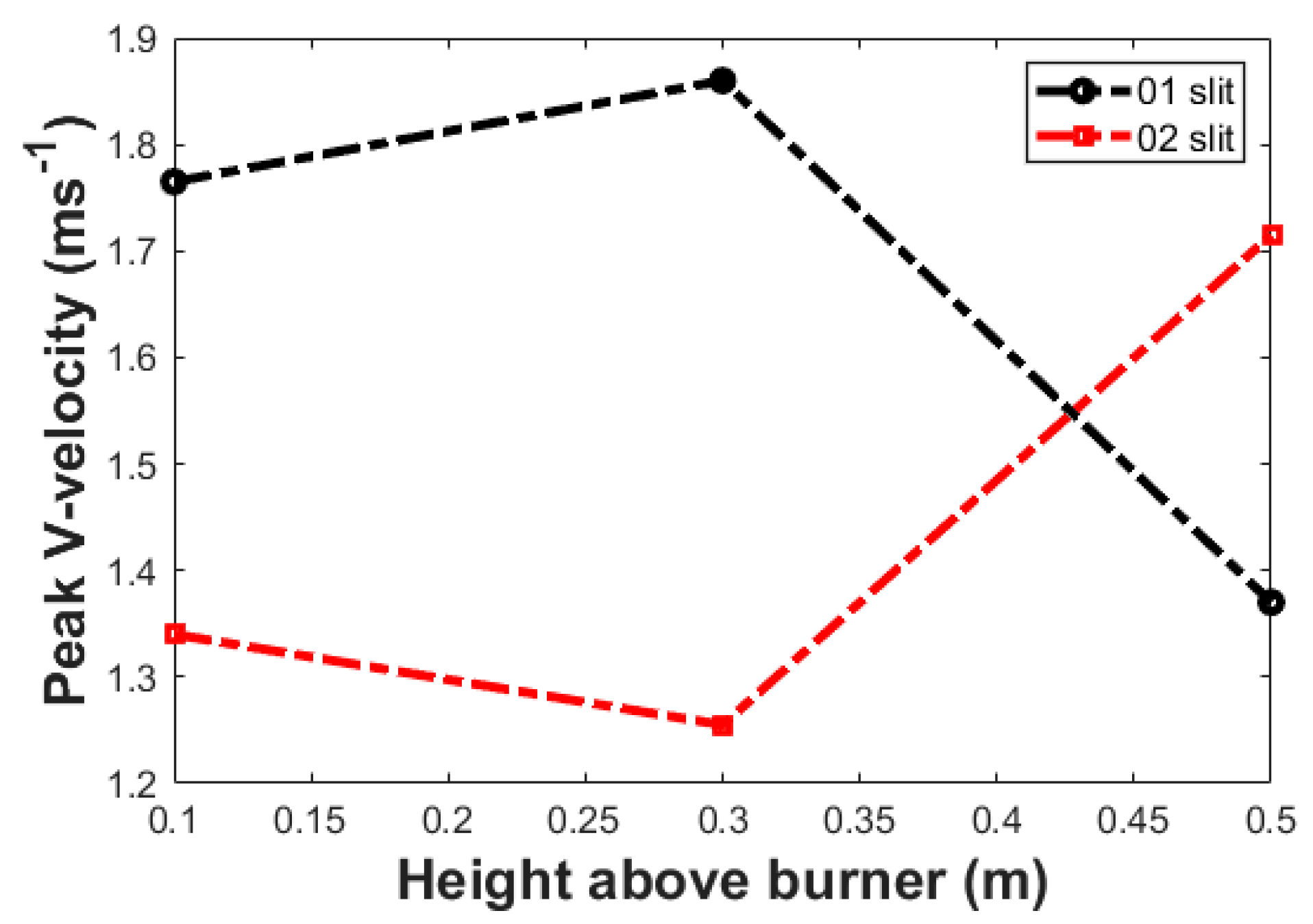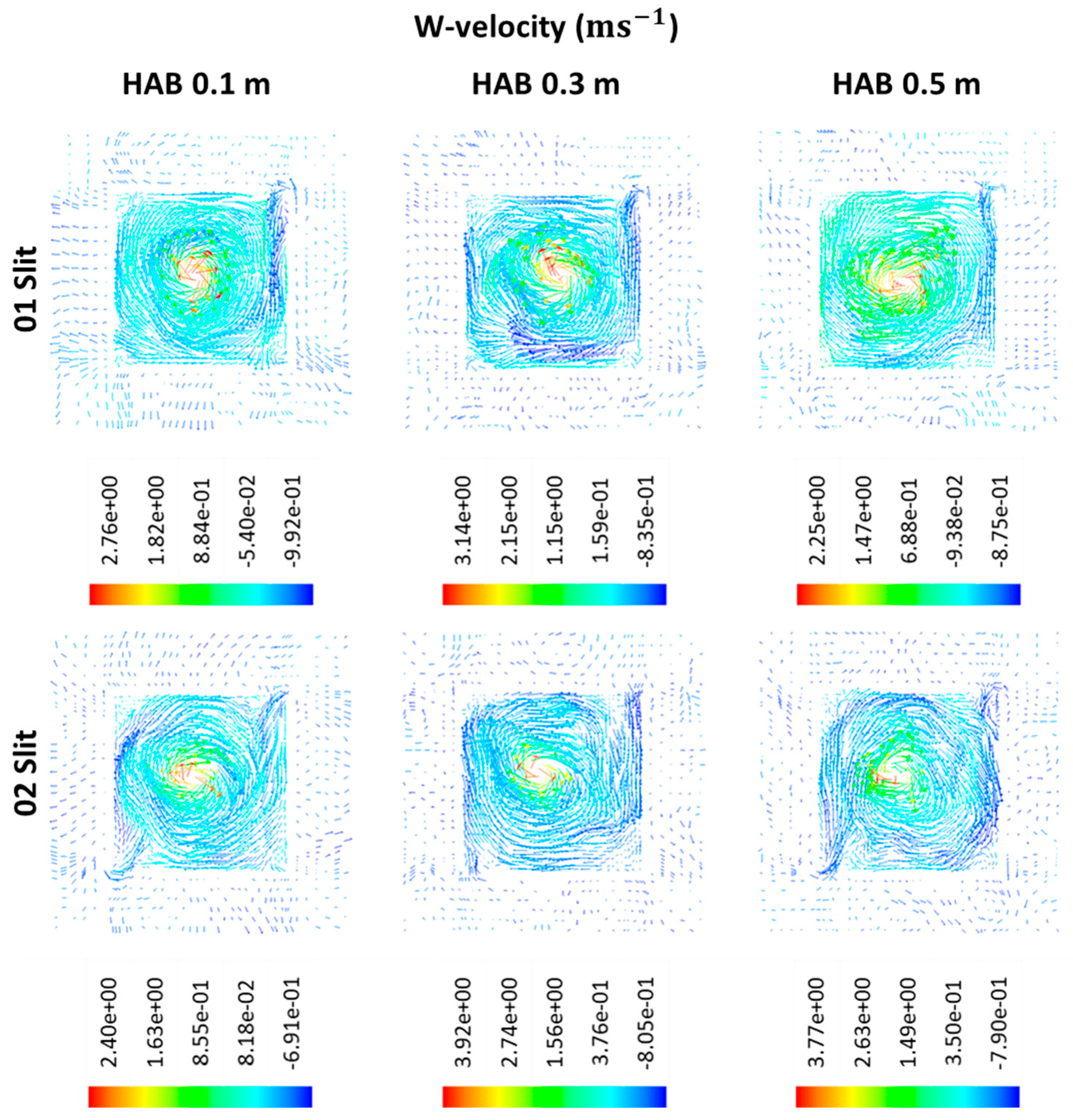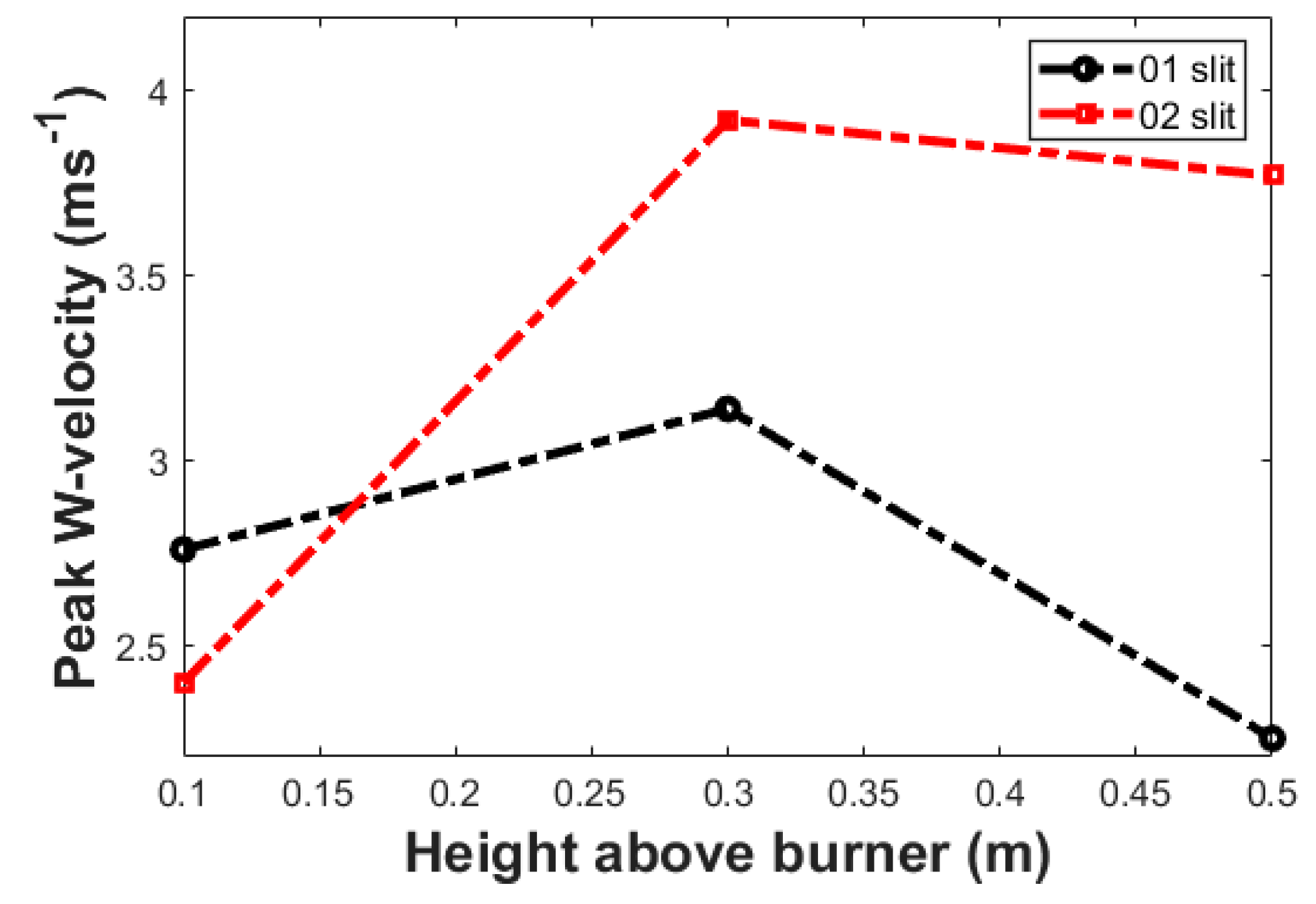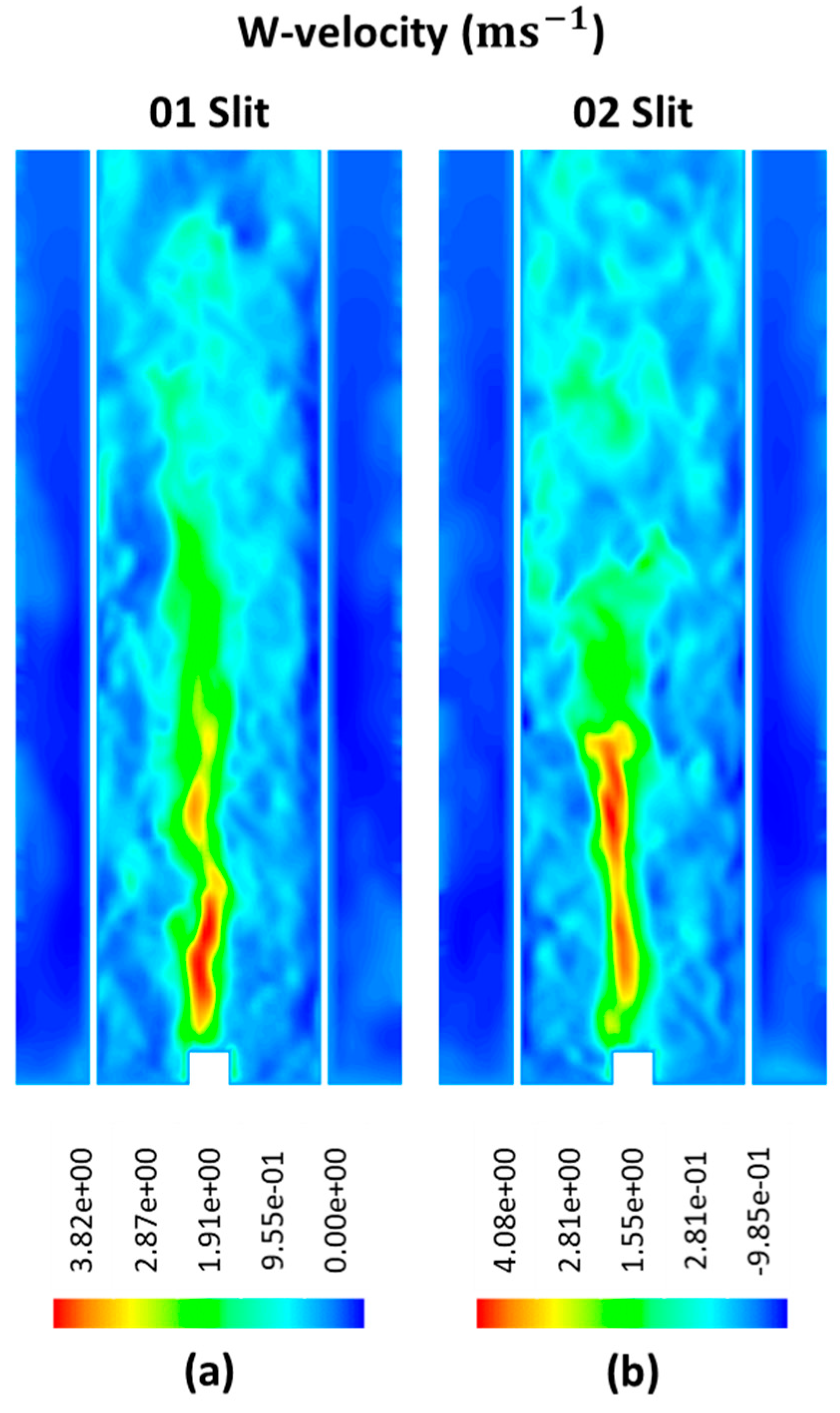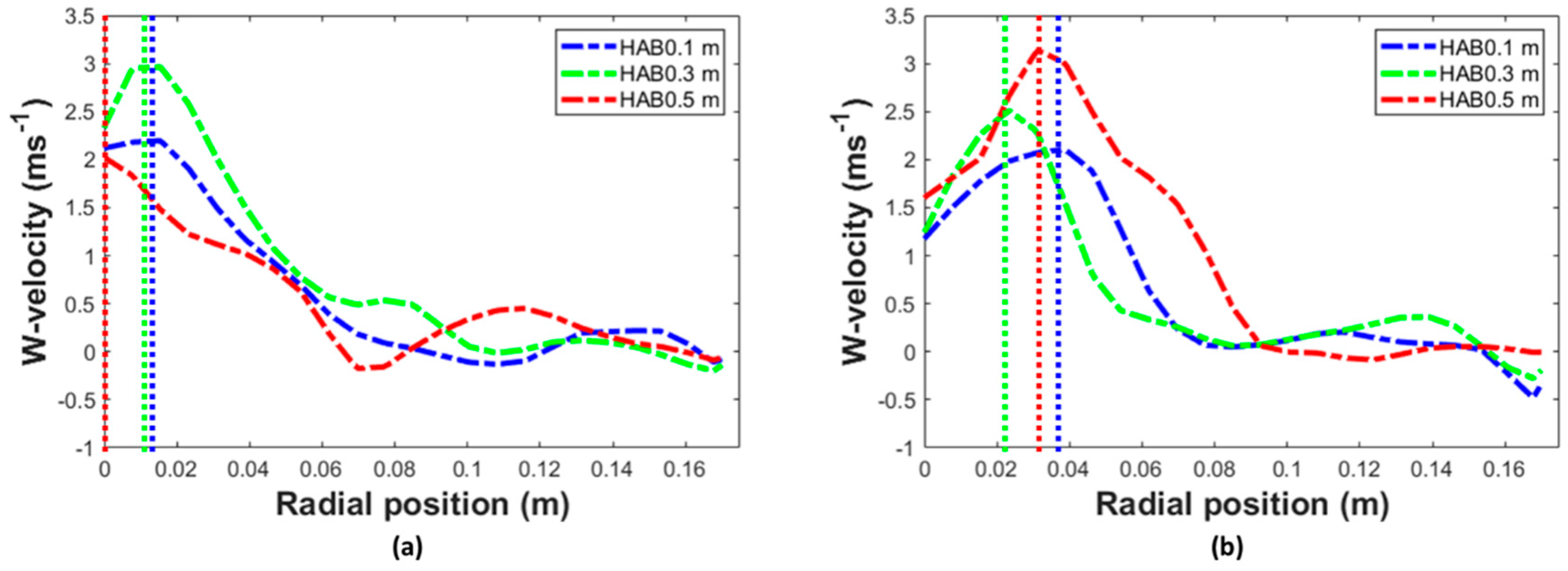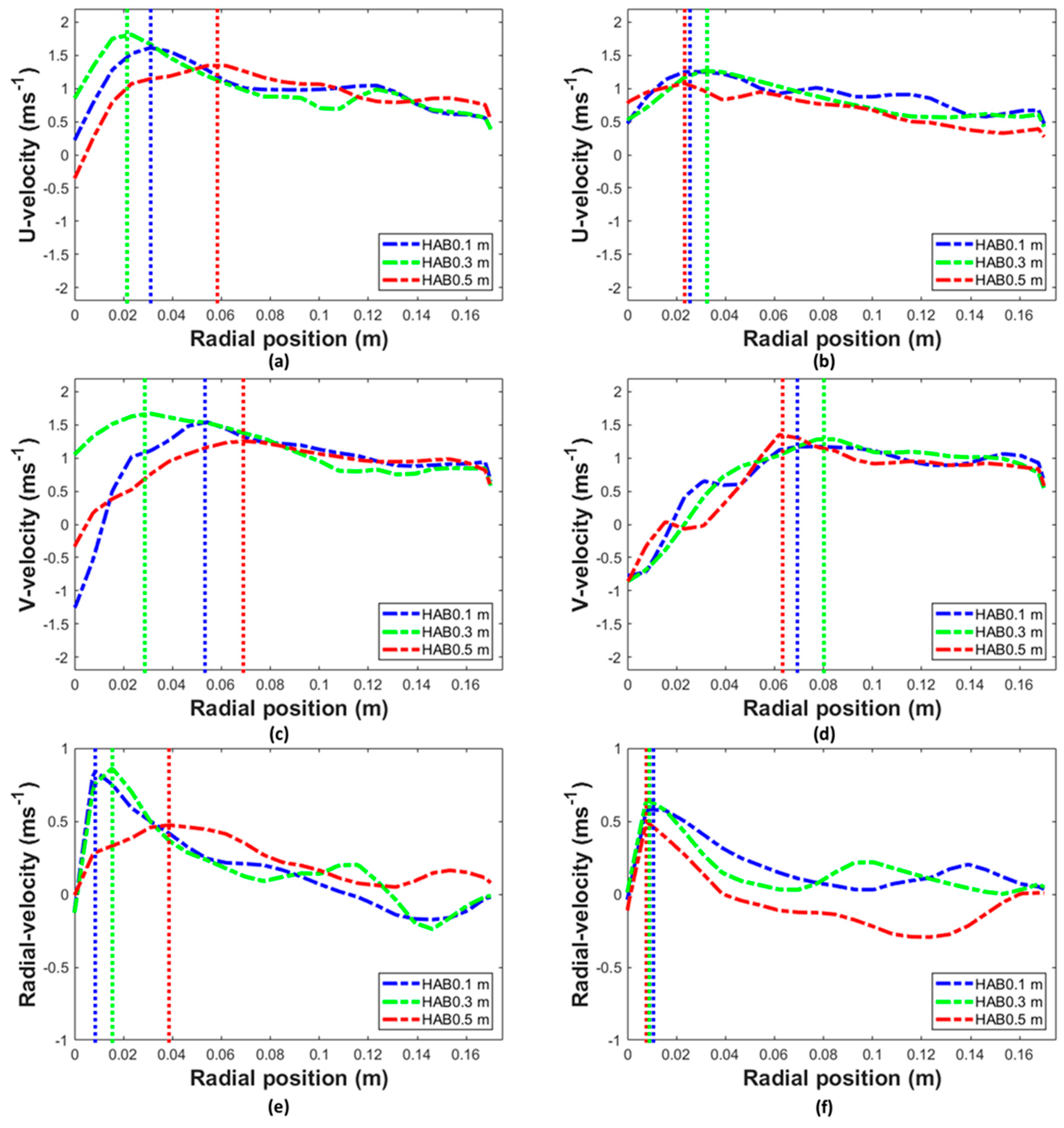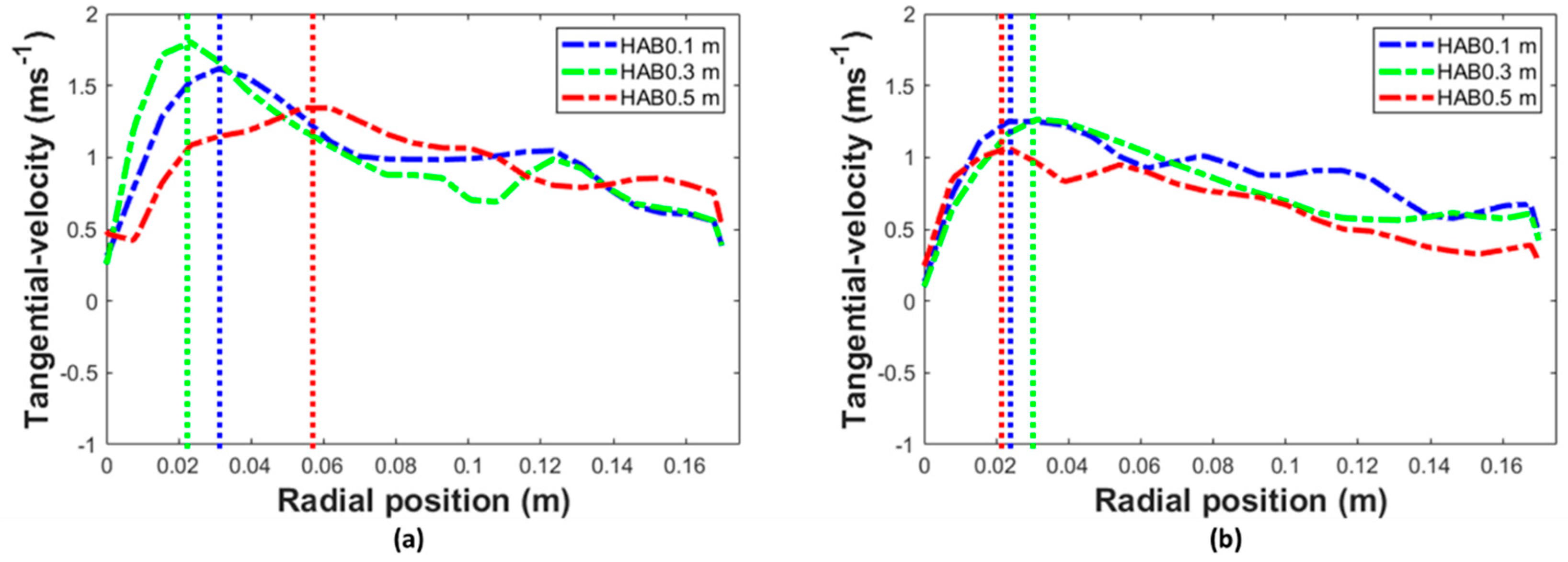1. Introduction
Fire whirl is a unique swirling diffusion flame that often occurs in urban and wildland fires with disastrous effects [
1]. The whirling combustion flow limits the radial flame dispersion and stretches the hot plume to rise upon an elevated vertical angular path, and as a result significantly increases the burning rate, flame height, and flame temperature and radiation flux to the surroundings [
2]. Owing to the unique features associated with this particular combustion dynamic behaviour, the formation of the fire whirl in a fire scenario can be devastated. For instance, the intense heat energy contained within the elongated fire whirl core combined with the radiative heat transfer to the surrounding, promote the fire propagation to the neighbouring points. The swirling motion associated with the fire whirl could also intensify the combustion process by enhancing the mixing of the combustible gas mixture with the oxidiser, while at the same time making the unsteady movement of the hot plume region even more spatially unpredictable [
3]. The presence of such phenomena associated with fire whirl has been observed and reported in many notorious fire cases [
4,
5], and it has been identified as the core factor in intensifying the combustion process and making the scenario unmanageable and untenable. For this very reason, fire whirls, in terms of their formation mechanisms, characteristic features, and physical behaviours, are of great interest to both the research and industrial sectors, and hence have been identified as the topic of interest for this study.
Previous experimental and theoretical studies have characterised and identified the three most critical criteria for the formation of a fire whirl, namely, a thermally driven fluid sink, a surface drag force to create a radial boundary layer, which facilitates air entrainment to the generated vortex column, and an eddy-generation mechanism [
6,
7,
8]. In a typical buoyancy-driven diffusion flame, the flame can be considered as the fluid sink and the generated hot plume naturally drives horizontal flow radically towards the vortex column [
9,
10], which fulfils the first two requirements. Therefore, the most critical element in fire whirl formation is the presence of a vortex generation mechanism. The generation of vortex could occur in a wildland fire situation, induced, for example, by topological obstacles, leeward slope, unpredicted weather conditions, etc. [
11,
12,
13]. The formation of such circulation can also be observed in a compartment fire scenario [
14,
15,
16], particular with the current trend of needing to construct high-density, high-rise buildings with complex geometric configurations. A typical example of a high-risk region for fire whirl formation is an enclosed space with entrainment from the flow channelling slit to introduce the circulation, for example, atrium, lift pit, spiral staircase etc., which are commonly featured in modern constructions. Despite the recently developed bio-based flame-retardant materials that effectively restrain the fire from spreading [
17,
18,
19,
20], the occurrence of the spinning flaming flow in skyscraper fires, such as the recent incidents in Beijing Television Cultural Center, Plasco Building, Grenfell Tower, Marina Torch, FR Tower, etc., could aggressively promote an alarming fire propagation within the confined space and cause catastrophic damages [
21]. This poses a severe risk to the occupants and makes the fire suppression process extremely challenging [
22,
23,
24]. Therefore, the characterisation of fire whirl formulated for enclosed configurations was targeted as the investigation case.
Fire whirl formulated in enclosed configurations has been intensively studied, both experimentally and numerically [
7,
25,
26,
27,
28,
29,
30,
31]. The literature has revealed an entangled coupling between the combustion process and the dynamic flow, i.e., the temperature, buoyancy, vortex, the combustion reaction, etc., are interrelated and interact during the formation of the fire whirl. Such interrelation between the involved physical and chemical aspects makes the understanding of the not-well-understood fundamentals of the swirling reacting flow more unfathomable. For instance, the existence of the whirling flame within the enclosure alters the heat feedback from the flame sheet to the fuel surface, and results in an unevenly distributed heating profile over the fuel surface. In a pool fire configuration, such ununiformed heat feedback could affect the burning rate as it influences the evaporation of combustible gas mixture converted from liquid-based parent fuel, and hence varies the ensuing combustion process and heat release rate [
32,
33,
34,
35]. Similarly, the residence of the whirling flame escalates the circulation within the enclosure, enhances the mixing of the oxidiser and reactant, and promotes a more completed combustion process. Theoretically speaking, the formation of soot species, the fine particles resulting from incomplete combustion, and the coupled radiative heat transfer to and from the surrounding, should be suppressed, when compared with non-swirling freestanding flame [
36,
37,
38,
39]. Nevertheless, the aggravation of the combustion process increases the flame temperature, which often excesses the threshold of soot nucleation, therefore aid the inception of in-flame generated soot species [
40,
41]. The excess generated soot species could arguably intensify the radiative heat transfer to the fuel surface and further boost the heat release rate, which contradicts with the previous speculation. In addition to the intricate physical and chemical coupling process, the uncertainty caused by the numerical modelling configuration could make the characterisation of fire whirl more cumbersome. For example, the combustion region of the fire whirl is likely to swirl around the domain which may involve tilting, stretching, converging etc. in a highly unpredicted manner. If the numerical domain is discretised non-uniformly, the variation in spatial resolution of the discretised region may significantly affect the evaluated result, particularly for the prediction of the sensitive flame temperature [
42].
The ambiguous correlation, involving various aspects, has nevertheless not been decoupled or restrained in many of the previous studies. Strategies, e.g., heavy sooty flame, pool-based flame generation mechanism where the burning rate depends on the evaporation rate, locally refined meshing algorithm with a denser grid at the domain centre, where a freestanding fire is expected to occur and coarse mesh at the fringes, etc., have commonly been adopted in previous studies, both experimental and numerical. Those implementations make quantitative analysis of the fire whirl behaviour unattainable. It is, therefore, critical to construct a numerical framework with the isolation and consideration of the preceding coupling parties, and focus on establishing the correlation between the eddy-generation mechanism and the characteristic of the formulated fire whirl.
In light of the abovementioned gap, the current study aims to characterise fire whirl formulated under various entrainment conditions via a numerical approach. The proposed numerical model, elaborated in more detail in the next section, is deliberately designed to isolate and restrain the coupling effect between some primary physical, chemical and numerical factors. The proposed model adopts soot-free and clean-burning alcohol-based fuel with a set injection speed, and aims to eliminate the soot radiative heat transfer to and from the surrounding, as well as the potential variation in the burning rate. In addition, the numerical domain of the entire enclosure, where both combustion and dynamic flow motion are expected to occur, is discretised with uniformed grid size to minimise the impact of the spatial resolution of computational control volume on the numerical result. The baseline case with one flow channelling slit is built and validated against experimental data. A modified case with the introduction of an additional entrainment slit is also constructed. The results generated by the two are compared and assessed.
2. Numerical Details
A numerical domain of the baseline model replicating the test rig of the previous experimental study [
43], as well as that with an additional flow channelling slit, was constructed accordingly. The geometric features of the two models are shown in
Figure 1. The fuel pan is converted from circular to square configuration with the same cross-section area as in the experimental setup to achieve a fully structured mesh, as this significantly improves the numerical accuracy and computational efficiency.
Despite the inevitable “flame wander” phenomenon, the domain is discretised to about elements based on a uniform division algorithm, to limit the numerical uncertainty associated with the spatial resolution of the discretised control volume. A doubling of the number of elements to resulted in only a difference in the centreline temperature, thus achieving a mesh-independent solution.
The fluid flow and heat transfer within the compartment is described through the conservation equations of continuity, Navier-Stokes, and scalar quantities:
where
and
are the mean density and pressure,
and
are the kinematic and turbulent viscosity,
and
are the Favre-averaged and fluctuation value of the mean fluid velocity,
and
are the mean and fluctuation value of the
th scalar,
and
are molecular and turbulent diffusivity, and
is the Favre-averaged chemical reaction source term.
Large eddy simulation (LES) with Wall-Adapting Local Eddy-viscosity (WALE) function, which accounts for both the strain and rotation rate of the turbulent structure is employed as the turbulence model to describe the turbulent reaction flow behaviour. This turbulence model has been extensively validated and proved to be a valid approach for resolving various wall-bounded turbulence flow applications [
8,
39,
44,
45,
46,
47,
48].
The chemical reaction source term in the transport equations of the involved reacting scalars is evaluated via the strained laminar flamelet approach. The involved chemical phenomenon is described as the pre-assumed probability density function (pre-PDF) of two quantities, namely the mixture fraction (
) and the scalar dissipation (
). Essentially, the mixture fraction governs the proportion of the fuel mixture in each control volume element in the discretised domain, and the first two moments of the mixture fraction, namely the mean mixture fraction,
, and the mixture fraction variance,
, are evaluated by resolving their conservation equations, respectively. Scalar dissipation is introduced to describe the strain and extinction of the flame, in which larger values of this quantity depict its departure from chemical equilibrium [
49]. The scalar dissipation across the flamelet is determined based on the mean scalar dissipation of the flamelets embedded in turbulent flames at the position where
, as well as the ratio of the function of the mixture fraction and density at the point of interest and at the position where
is stoichiometric. A detailed GRI-MECH
chemical reaction mechanism, with the inclusion of
reaction steps and
chemical species [
50], is implemented to establish the flamelet library of the strained laminar flamelet model considering parental fuel. This approach has been validated in previous numerical studies for modelling turbulence chemistry interaction, and has been proved to provide a reasonable result with moderate computational consumption [
44,
51]. It should be highlighted that methanol (
), an alcohol-based fuel, was deliberately selected as the parent fuel to minimise the coupling between radiative energy feedback and the combustion process, due to its feature of clean and soot-free burning behaviour [
41]. For the same reason, the concentration of the key intermediate species of soot formation, acetylene (
), in the gas mixture produced by this very parent fuel, is proved to be negligible. The most commonly adopted soot models formulated on
precursor-based inception and surface growth mechanism are not applicable in this study [
52,
53,
54,
55]. As a result, a primitive and computational lightweight two-step soot model is integrated, for concept verification purpose only.
With respect to the boundary conditions, a set flow rate of in the direction normal to the fuel surface is applied on the fuel pan. The applied injection velocity is determined on the basis of the cross-sectional area of the fire pan, the density of the parent fuel at reference temperature, and the heat of combustion of the parent fuel in order to match the targeted heat release rate reported in the experimental study. The constant injection rate ensures an evenly distributed burning profile, regardless of the intensity of flow circulation and energy feedback. The fuel surface is set at an elevated height according to the experimental setup. The top and the periphery of the domain is set as the opening to allow naturally convected air entrainment in and out of the system. The base of the domain is set as a non-slip adiabatic wall, across which no heat or matter is allowed to pass. The simulation is initiated with a standard temperature and pressure replicating the ambient conditions for the combustion process to proceed. For convenience, the case with one side entrainment slit is referred to as the slit case, case , or the baseline case/model, and that with two side entrainment slits is referred as the slit case, case , or the comparison case/model, in the following sections.
3. Results
The numerical result generated via the baseline case is firstly validated against the experimental data [
43], and the characterisation of the fire whirl evaluated via the two cases is subsequently assessed and discussed in the following section.
3.1. Validation
An accurate description of the fire whirl’s inner structure is intimately tied with a proper description of the temperature and the velocity field of the swirling reacting flow. For this reason, the temperature and velocity profile generated by the baseline model is used to compare with the that reported in the literature for validation purpose.
Due to the constraints related to the physical set up and experimental design, limited information is provided in prior studies. For clarity, herein, temperature measurement at domain centreline at various HABs is selected for comparison. Furthermore, the incoming y-velocity profile through the air gap is also validated against a prior numerical investigation of the similar experimental setup [
8]. The result of the validation procedure is presented in
Figure 2 and
Figure 3.
It can be seen from
Figure 2 that the centreline temperature peaks at about HAB
and sharply decreases to ambient as the combustion process develops towards downstream. Similarly, high incoming velocity at the air gap is observed in the low-intermediate region, and its quantity gradually drops with the increase of flame height. Despite the fact that the flame temperature in the intermittent region is slightly overestimated, potentially attributed to the absence of radiation correction, as well as the inevitable flame flickering, the comparison shows good agreement between the numerical simulation and experimental data. As presented in
Figure 3, a similar agreement could be reached in the comparison of incoming y-velocity through the air gap with the prior study.
In addition, the soot volume fraction evaluated from both cases is proved to be negligible, i.e., on an order of magnitude of and in the baseline and comparison cases, respectively. It was further ascertained that with the adoption of the alcohol-based parent fuel, the in-flame soot formation and the ensuring radiation feedback can be safely neglected in this study.
With the numerical model of the baseline case validated, the model of the two slits cases is constructed accordingly, by implementing the identical numerical setup on the geometry with the introduction of an additional flow channelling slit. The result generated by the two slits model is therefore assumed to be justified. Temperature and velocity profiles, as mentioned, are the primary parameters for characterising the swirling reacting flow involved in the fire whirl. The assorted temperature and velocity data generated numerically by the baseline model are presented alongside those of the comparison model, to assess the effect of the geometrical configuration on the formation of fire whirl.
3.2. Temperature
The thermal component of the flame is undeniably the most critical aspect to be investigated in fire modelling. It is more critical in this study of fire whirl, as the temperature and velocity are interrelated, and such coupling is essential for the understanding of the ensuing formation and sustenance of the swirling combustion phenomenon. The qualitative analysis of the fire whirl therefore starts by assessing the temperature profile of the formulated swirling reacting flow field.
The temperature iso-surface of the flame generated by the two cases, presented in
Figure 4, provides a glance of the geometric characteristics of the fire whirl formulated under different entrainment boundary conditions. The figure shows that, with the side flow channelling slit(s) acting as the eddy-generation mechanism, a highly twisted flow field with relatively high temperature can clearly be observed in both geometric configurations. This temperature profile exhibits a helical form, implying the persistence of strong swirl motion within the core structure of both flames. To be more specific, the fire whirl generated from the baseline model is exhibited in the format of a tortuous and highly twisted string. The hot plume accumulates and exits up near exit region in the vertical orientation. Whereas the fire whirl of that generated via the two-slit configuration resembles a convoluted cylinder centred on the lower-mediate region of the computational domain.
The temperature contour of a cross-sectional plane of the computational domains of the two cases is illustrated in
Figure 5a,b. The contour plot shows that the maximum flame temperature of the case with the two-slit configuration is higher, i.e., increased by about
, when compared with the baseline. Similar to the temperature iso-surface presented above, the cloud of the hot plume, accumulated at the downstream region observed in the baseline case, is cleared out when the additional slit is introduced.
The visible flame height of the two cases determined based on applying the cut the cut-off visible flame tip temperature of
is presented in
Figure 5c,d. From the comparison, it is evident that the visible flame height for two-slit configuration grows significantly compared with that of the baseline model, i.e., it is increased by
from
to
.
The extension of the flame height of the comparison model is further verified by comparing the spatial temperature distribution, along with the lateral direction, as presented in
Figure 6. Theoretically, the peak flame temperature of a typical diffusion flame should occur at the reaction layers, i.e., the intersection where the fuel and the oxidiser encounter each other and react due to diffusion. The reaction layer in the continuous and intermittent region of a diffusion flame is typically away from the flame centreline, and as a result, the spatial distribution of the flame temperature should resemble a hump-like profile. The hump-like profile tends to shift to a Gaussian distribution, with its value maximised at the centreline, as the flame flows further to the downstream, i.e., enters the plume region.
The transition from a hump-like profile to a Gaussian distribution can be observed in the baseline model, as the HAB increased from to . This implies that the domain from HAB and beyond of this very flame can be identified as the plume region. On the other hand, the temperature profile generated by the slit case features a hump-like profile for all monitoring HABs, means that the flaming structure up to HAB of this fire whirl can still be considered to be in the continuous and intermittent region. This therefore indicates that the flame height of the swirling reacting flow triggered by the intensified circulation is significantly higher compared with the baseline model.
It is also worthwhile assessing the temperature core radius
, defined as the radial location where the excess temperature declines to half of the maximum recorded value, at the monitoring HABs of the two cases. Pioneer studies of the fire whirl suggested that the flame pulsation behaviour is suppressed in the continuous flame region due to the cyclostrophic balance effect, resulting in a near-constant temperature core radius. As the flame enters the plume region, the temperature core radius increases proportionally with the flame height [
33].
As reported in
Table 1, the temperature core radius of the baseline model expands significantly; for example, it is increased by
from
at HAB
to
at HAB
, while that of the
slit case is reported to be nearly identical at all monitoring HABs. The results suggest an elongated continuous flame region of the
slit model when compared with that of the baseline.
The preceding comparison of the spatial temperature distribution demonstrated that, as a buoyant driven diffusion flame, the intensification of the eddy generation promotes the air entrainment from the surroundings, enhances the mixing of fuel and oxidizer. This facilitates the combustion process, hence resulting in the formation of the flame field with higher peak temperature. The additional entrainment induced via the extra slit also amplifies the generation of vorticity, aggravates the swirl motion, and escalates the formulation of fire whirl, which leads to intensified combustion reactions and elongated combustion region. In addition, for this very reason, the slit model promotes natural ventilation at the near exit region, and as a result, the hot plume is entrained out of the computational domain more effectively compared with slit configuration.
3.3. Velocity
To characterise the fire whirl formulated under various entrainment conditions, it is imperative to evaluate and assess the related velocity field. In essence, the inner structure of an on-source fire whirl can be approximated as a 3-dimensional flow. The following vector plot, as well as the peak value of the velocity of U, V and W at all monitoring HABs, presented in
Figure 7,
Figure 8,
Figure 9,
Figure 10,
Figure 11 and
Figure 12, illustrates the key features of the flow behaviour of the swirling flame structure of both cases. This provides compelling evidence that, with the introduction of the slit to trigger eddy generation, the presence of the highly swirled reacting flow field, i.e., the formation of the fire whirl, can be confirmed. Such whirling motion within the flame structure can be observed at all HABs of interest for both geometric configurations.
The peak value of the associated velocity at three monitoring HABs is plotted in
Figure 8,
Figure 10 and
Figure 12. The comparison indicates that the peak values of U, V, and W velocity of the baseline model tend to firstly increase in the region between HAB
and HAB
, and then decrease sharply as the combustion spreads to downstream HABs. Meanwhile, for the
slit configuration, the magnitude of the drop of the assorted velocities from HAB
to HAB
is observed to be moderated compared with the
slit configuration. For example, the results report a
,
and
variation in U, V, and W velocity between HAB
and HAB
of the
slit case, compared with that of
,
and −28.34% of the baseline.
The dampened reduction in U and W velocity and the significant increase in V velocity from HAB to HAB demonstrate that, with the introduction of additional air entrainment slit, the formulated flame is still in the developing phase, i.e., in the continuous and intermittent regions at HAB of . Meanwhile, the flame yield for the baseline model is well-developed, and reached the plume region at the same elevated height; hence, it possesses a shorter flame length, which is in good agreement with the speculation deduced from the preceding analysis of the temperature profile.
3.3.1. Axial Velocity
The axial velocity contour of a cross-sectional plane generated by the two cases is presented in
Figure 13 for comparison. The contour plot depicts that the maximum axial velocity of the case with
slit configuration is higher, i.e., increased by
, when compared with that of the baseline model. The region in which axial velocity is dominant was also extended with the introduction of additional air entrainment slit. The axial velocity dominant region, determined as the vertical location at which the excess axial velocity decreases to half of the maximum recorded value, increased by
to
, compared with
for the baseline model.
The promotion of axial velocity in the
slit case is further justified by assessing the spatial distribution of the axial velocity plotted against the lateral direction at the monitoring HABs, presented in
Figure 14. The literature reveals that the axial centreline velocity accelerates upwards to maximum in the continuous flame region. Due to the velocity fluctuation, the axial centreline velocity decreases sharply as the HAB increases to intermittent regions, and further decelerates to ambient conditions as it enters the plume region [
56,
57]. Such a transition can be clearly seen in the velocity profile yield from the baseline model, indicating that the continuous and intermittent region of the fire whirl generated in the baseline case should be well below HAB
. Meanwhile, the peak axial centreline velocity reported in the comparison case is presented in an incremental pattern as the flame developing in the downstream direction, suggesting an extended continuous region when compared with the baseline case.
In addition, experimental data of PIV measurements confirmed that within the continuous flame region, the axial velocity reaches its maximum value in the vicinity of the reaction layer, i.e., away from the flame centreline, and its profile resembles a hump-like distribution along the radial direction. With increasing height from the intermittent flame region and beyond, the location of maximum excess temperature shifts toward the whirl’s centreline and forms a Gaussian profile [
27]. The transformation of the axial velocity profile from hump-like to Gaussian form, evidently observed in the baseline model as the HAB increased from
to
, however, had not yet occurred in the
slit model. The hump-like profile at all monitoring HABs up to
in the comparison case again confirms the extension of the continuous flame region, i.e., to and beyond HAB
, when compared with single slit configuration.
3.3.2. Radial Velocity and Tangential Velocity
The profile of U, V and radial velocity, plotted as a function of the radial position at three monitoring HABs, is presented in
Figure 15. The transformation of the profile of U, V and radial velocity from hump-like to a plateau with the increase of flame height was observed in the baseline model, whereas that hump-like velocity profile is inherently persistent in all HABs in the
slit case. Furthermore, the radial location at which the velocity of interest peaks shifts away from the centreline axis with an increase in the flame height in the baseline case, whereas this is nearly identical at all HABs in the comparison case. It has been described in prior studies that the maximum radial velocity occurs adjacent to the surface and reverses direction close to the upper parts of the boundary layer, indicating the presence of the circulation zone [
26]. The departure of the boundary layer of the circulation zone away from the centreline, observed in the baseline case, implies the dissipation of the fire whirl core region. In other words, the flame departs from the continuous and intermittent region and enters the plume zone at the elevated height of
. The near-constant radial position of the peak radial velocity observed in the
slit case depicts a well-maintained fire whirl core structure, i.e., the flame at high elevations can still be considered to be within the continuous region. The combustion region of the comparison case, therefore, is demonstrated to be well-extended compared with that of the baseline.
Circulation is indeed the unique feature distinguishing fire whirls from non-swirling fires. The presence of the circulation disturbs the flow field and alters the ensuing combustion process, as a result significantly affecting assorted properties, such as flame temperature, combustion dominant region, as well as the velocity profile. The circulation is characterized by assessing the azimuthal velocity, or tangential velocity, in this study. Herein, the tangential velocity against the radial position at the selected HABs of the cases of interest is plotted in
Figure 16.
Similar to the profile of radial velocity, The humped-like profile turns to flat and the radial location where the tangential velocity peaks departs away from domain centreline with the increase of flame height in the baseline model, while those of the comparison case remains relatively unchanged at all monitored heights.
To further elaborate the transition, the mean whirl vortex core radius at the elevated heights of the two cases are evaluated and listed in
Table 2. The mean whirl core radius is determined based on the azimuthal velocity profile, i.e., the radial location at which the tangential velocity is at its maximum, and beyond which the circulation becomes nearly constant. The results reveal that the mean whirl core radius of the baseline case departs significantly from the centreline axis, i.e., it increases by
from
at HAB
to
at HAB
, while that reported for the
slit case is nearly identical at all monitoring HABs. Previous experimental study examining the correlation between the fire whirl radius and the stage of combustion suggests a reasonably constant whirl core radius in the continuous flame region, which increases with flame height in the intermittent and plume regions [
33]. The results presented in
Table 2, therefore, again verify the abovementioned speculation that the combustion region is well maintained and is extended by means of the introduction of the additional flow channelling slit.
In addition, by comparing the results presented in
Table 2 with those in
Table 1, it can be concluded that the radius determined based on the temperature is generally larger than that based on circulation, which again is in good agreement with the experimental observations [
1].
Collectively, the preceding assessment of the axial, radial and tangential velocity demonstrates that, with the additional vorticity induced by the entrainment via the additional slit, the swirling motion within the domain is intensified, and the circulation of the dominant region is elongated. The intensified circulation enhances the mixing of the oxidiser with combustible gas mixtures and facilitates the ensuing combustion process. As a result, a quasi-steady, on-source fire whirl with a unique flow core structure that extended to a higher elevated HAB was formulated and well maintained
4. Conclusions
A numerical simulation of a unique combustion process occurring in an enclosed configuration with one or two side entrainment slit(s) was performed to assess the character of a fire whirl formulated by means of various eddy-generation mechanisms. The numerical framework of the proposed model consists of the WALE large eddy simulation turbulence model coupled with reduced detailed chemistry to describe the intricate whirling flaming flow behaviour. The numerical model adopts a uniformed structured discretisation scheme, a fixed fuel injection rate, and a soot-free alcohol-based parent fuel, to isolate and constrain the complicated coupling effect between the combustion process and the flow dynamics.
The numerical simulation of the baseline model consists of one flow channelling slit, replicating the test rig layout in the literature. This was firstly validated against experimental data and achieved satisfactory agreement. A modified model built with the introduction of an additional slit was subsequently constructed, and the results generated were compared with the baseline for assessment. The analysis concluded that, with the intensified eddy-generation mechanism,
The peak flame temperature of the formulated fire whirl increased by , from to ;
The visible flame height increased by , from to ;
The axial velocity and the axial velocity dominant region increased by and by , respectively;
The flame structure was well-maintained as the temperature core radius remained relatively unchanged at all monitoring HABs, compared with the increase by in the baseline case;
The circulation core structure was well-sustained, and the mean vortex core radius was observed to be nearly identical at the elevated height of up to , whereas there was an increase of in the baseline case.
In summary, the results generated from this numerical study demonstrate that the addition of an introduced slit intensifies the circulation, enhances the mixing of the oxidiser with the reactants, and hence facilitates the ensuing combustion process. As a result, the numerical model with stronger eddy-generation mechanisms, i.e., featuring two flow channelling slits, formulates and sustains a fire whirl possessing an elongated, constrained and swirling combustion region, compared with those generated from the single-slit configuration. In addition, this numerical study showcases the capability of the proposed numerical framework to capture various features of the whirling reacting flow, which are often difficult to acquire and assess by experimental means. The model also provides visualised information on the combustion process and flow field, thus delivering theoretical insight. The numerical model presented in this study, is therefore proved to be a feasible tool for assisting the understanding of the fundamentals of the formation and evolution of this intriguing combustion phenomenon.
